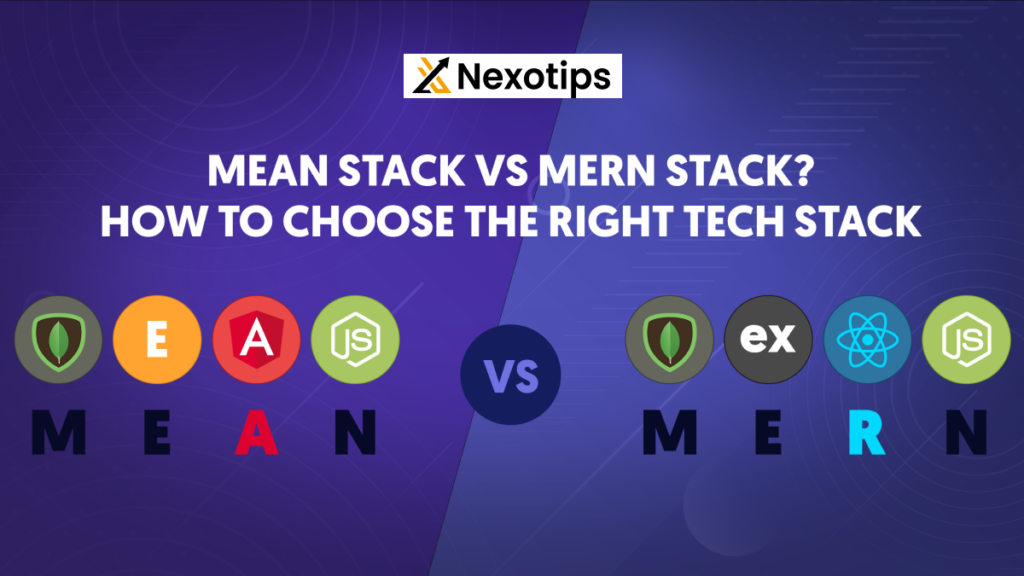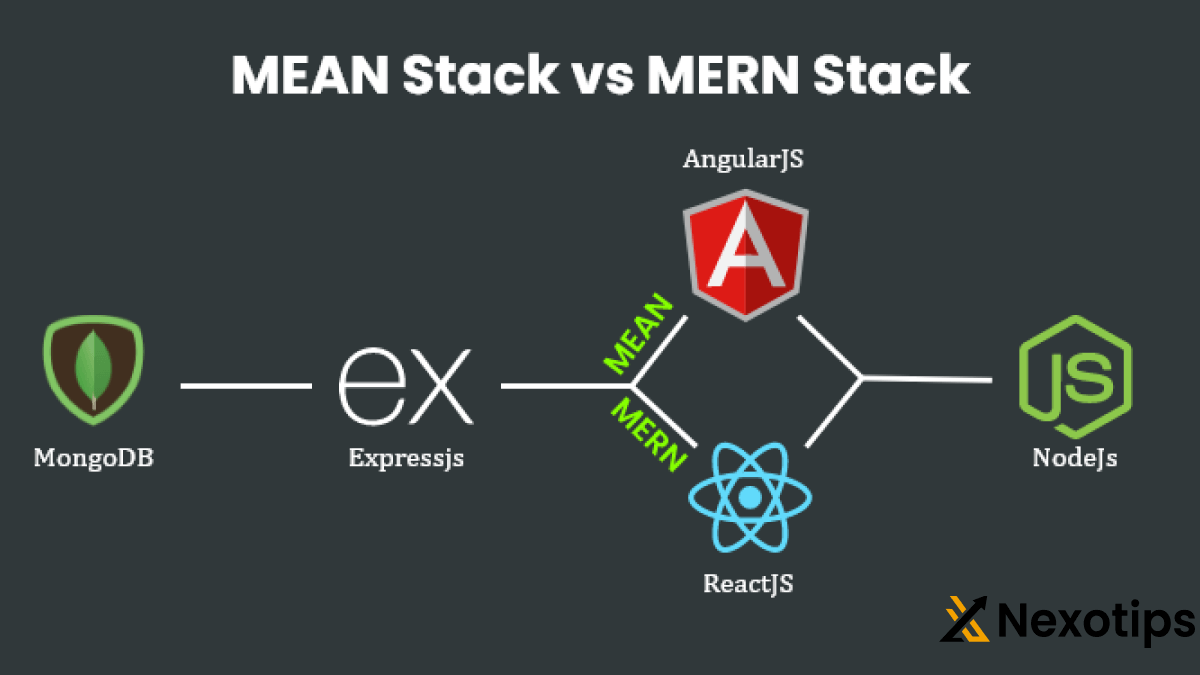
Decoding the Future 2024: Which Developer Stack Will Dominate MEAN or MERN ?
Which Developer Stack Will Dominate MEAN or MERN ?
Which Developer Stack Will Dominate MEAN or MERN ? In the dynamic landscape of web development, two prominent stacks have emerged as frontrunners, each offering unique advantages and catering to diverse development needs. We delve into the MEAN and MERN stacks, dissecting their components, functionalities, and suitability for various projects to elucidate which might best align with your development endeavors.
MEAN Stack: A Comprehensive Overview
Introduction to MEAN
The MEAN stack comprises four key technologies: MongoDB, Express.js, AngularJS (or Angular), and Node.js. It represents a full-stack JavaScript framework used for building dynamic web applications and is renowned for its flexibility, scalability, and ease of use.
Component Breakdown
- MongoDB: A NoSQL database that stores data in flexible, JSON-like documents.
- Express.js: A minimal and flexible Node.js web application framework that provides a robust set of features for web and mobile applications.
- AngularJS/Angular: A JavaScript framework maintained by Google, AngularJS (v1) or Angular (v2+), facilitates the development of single-page applications (SPAs) by extending HTML syntax and providing dynamic views.
- Node.js: A server-side JavaScript runtime environment that executes JavaScript code outside a web browser.
Advantages of MEAN Stack
- Uniform Language: Utilizing JavaScript across the entire stack streamlines development and promotes code reuse.
- JSON Flexibility: MongoDB’s JSON-like document structure harmonizes with JavaScript, facilitating seamless data handling.
- Real-time Capabilities: Node.js enables real-time communication between client and server, ideal for applications requiring instant updates.
Use Cases
The MEAN stack excels in developing real-time applications, such as chat applications, collaborative tools, and streaming platforms. Its flexibility and scalability make it well-suited for startups and enterprises alike, particularly those prioritizing rapid development and deployment.
MERN Stack: A Comprehensive Overview
Introduction to MERN
Similar to MEAN, the MERN stack consists of four core technologies: MongoDB, Express.js, React, and Node.js. However, MERN swaps out Angular for React, providing an alternative approach to building dynamic web applications.
Component Breakdown
- MongoDB: Retaining its role as the NoSQL database, MongoDB stores data in a flexible, JSON-like format.
- Express.js: Functions identically to its MEAN counterpart, serving as a minimal and flexible web application framework for Node.js.
- React: Developed by Facebook, React is a JavaScript library for building user interfaces, focusing on component-based architecture and virtual DOM for optimal performance.
- Node.js: Retains its role in the MERN stack, offering server-side JavaScript execution.
Advantages of MERN Stack
- Virtual DOM: React’s virtual DOM enhances performance by minimizing unnecessary re-rendering, resulting in faster user interactions.
- Component Reusability: React’s component-based architecture fosters modular development, promoting code reusability and maintainability.
- Community Support: React boasts a vast and active community, with extensive documentation and a plethora of third-party libraries and tools.
Use Cases
The MERN stack is ideal for building interactive user interfaces and single-page applications (SPAs) with complex user interactions. It caters well to projects requiring high interactivity and rapid data updates, making it suitable for social media platforms, e-commerce sites, and data-driven applications.
Choosing the Best Stack: MEAN vs. MERN
Considerations
- Project Requirements: Assess the specific needs of your project, including scalability, real-time capabilities, and complexity of user interactions.
- Developer Familiarity: Evaluate the expertise of your development team with each technology stack, as familiarity can significantly impact productivity and code quality.
- Community Support: Consider the availability of resources, documentation, and community support for troubleshooting and extending functionalities.
Conclusion
Both the MEAN and MERN stacks offer robust solutions for web application development, each with its unique strengths and applications. While MEAN prioritizes real-time capabilities and uniformity with JavaScript, MERN emphasizes performance optimization and component-based architecture. Ultimately, the choice between the two hinges on the specific requirements and objectives of your project.
In conclusion, understanding the nuances and distinctions between the MEAN and MERN stacks empowers developers to make informed decisions that align with their project goals and objectives.
Comparative Analysis of MEAN and MERN
Performance and Scalability
One of the key considerations when choosing between the MEAN and MERN stacks is performance and scalability. Both stacks offer robust performance due to their use of JavaScript across the entire development stack. However, the choice between Angular and React can significantly impact performance and scalability.
MEAN Stack Performance
In the MEAN stack, AngularJS (or Angular) offers a comprehensive framework for building complex and dynamic user interfaces. Angular’s two-way data binding and dependency injection contribute to a seamless user experience. However, as applications built with Angular grow in complexity, they may experience performance issues due to the framework’s digest cycle.
MERN Stack Performance
React, on the other hand, employs a virtual DOM to optimize performance by minimizing unnecessary re-renders. The virtual DOM efficiently updates the actual DOM, resulting in faster rendering and improved performance, particularly for applications with high user interactivity and frequent data updates.

Also Read: Angular 11 Vs Angular 12 : Evolution, Features, And Performance Compared
Development Speed and Ease of Use
Another crucial factor in choosing between the MEAN and MERN stacks is development speed and ease of use. Both stacks leverage JavaScript, offering a unified language for development. However, the frameworks and libraries used in each stack may differ in terms of ease of use and developer productivity.
MEAN Stack Development Speed
The MEAN stack, with AngularJS (or Angular) as its frontend framework, provides a comprehensive set of tools and features for building robust web applications. Angular’s CLI (Command Line Interface) simplifies project setup and configuration, streamlining the development process. Additionally, the MEAN stack’s adherence to MVC (Model-View-Controller) architecture promotes code organization and maintainability, contributing to faster development speed.
MERN Stack Development Speed
In comparison, the MERN stack’s use of React offers a lightweight and flexible approach to frontend development. React’s component-based architecture encourages code reusability and modularity, facilitating faster development iterations. Additionally, the MERN stack’s reliance on Node.js for backend development enables full-stack JavaScript development, eliminating the need for context switching between different programming languages.
Community Support and Ecosystem
Community support and ecosystem play a vital role in the success and longevity of a technology stack. Both the MEAN and MERN stacks benefit from active and vibrant communities, offering extensive documentation, tutorials, and third-party libraries and tools.
MEAN Stack Community Support
The MEAN stack, with its roots in AngularJS (or Angular), enjoys robust community support from Google and the wider developer community. Angular’s extensive documentation, official guides, and vibrant community forums provide valuable resources for developers of all skill levels. Additionally, the MEAN stack’s use of MongoDB and Node.js benefits from active community contributions, with a plethora of third
party modules and plugins available for enhancing functionality and addressing specific use cases.
MERN Stack Community Support
Similarly, the MERN stack benefits from a thriving community centered around React and Node.js. React’s popularity has spurred the development of numerous third-party libraries, UI component libraries, and development tools, further enriching the ecosystem. Additionally, Node.js’s vast repository of npm packages provides developers with access to a wide range of modules for building scalable and efficient backend services.
Learning Curve and Developer Experience
When evaluating the MEAN and MERN stacks, it’s essential to consider the learning curve and developer experience associated with each technology. While both stacks leverage JavaScript, the frameworks and libraries used in frontend development may have varying degrees of complexity.

MEAN Stack Learning Curve
AngularJS (or Angular), as the frontend framework in the MEAN stack, has a steeper learning curve compared to React. Angular’s opinionated approach and comprehensive feature set may require developers to invest more time in learning the framework’s concepts and best practices. However, once developers become proficient in Angular, they can leverage its powerful features for building scalable and maintainable web applications.
MERN Stack Learning Curve
In contrast, React’s minimalist and declarative approach to building user interfaces results in a shorter learning curve for developers. The React ecosystem prioritizes simplicity and flexibility, allowing developers to focus on building reusable components and managing state efficiently. As a result, developers familiar with JavaScript and HTML can quickly grasp React’s core concepts and start building interactive user interfaces.
Scalability and Maintainability
Scalability and maintainability are critical considerations for long-term success in web development projects. Both the MEAN and MERN stacks offer scalability through their use of JavaScript and support for asynchronous, non-blocking I/O operations. However, the choice between Angular and React may impact the scalability and maintainability of the frontend codebase.
MEAN Stack Scalability and Maintainability
The MEAN stack’s adherence to MVC architecture promotes code organization and maintainability, enabling developers to separate concerns and manage complexity effectively. Angular’s modular structure and dependency injection facilitate code reuse and scalability, allowing applications to grow in functionality without sacrificing maintainability.
MERN Stack Scalability and Maintainability
Similarly, the MERN stack’s component-based architecture encourages code modularity and reusability, facilitating scalability and maintainability. React’s focus on functional programming and immutable data structures promotes predictable behavior and simplifies debugging and refactoring, contributing to a more maintainable codebase.
Conclusion: Choosing the Right Stack for Your Project
In conclusion, the choice between the MEAN and MERN stacks depends on various factors, including project requirements, developer expertise, and long-term objectives. While both stacks offer robust solutions for building modern web applications, each has its strengths and considerations.
- Choose MEAN Stack If:
- Your project requires real-time capabilities and uniformity with JavaScript.
- Your development team is proficient in Angular and prefers a comprehensive framework for frontend development.
- You prioritize ease of setup and configuration, with built-in support for MVC architecture.
- Choose MERN Stack If:
- Your project emphasizes performance optimization and component reusability.
- Your development team prefers a lightweight and flexible approach to frontend development, with a focus on React’s virtual DOM.
- You value a vibrant and active community, with extensive documentation and third-party library support.
Ultimately, understanding the nuances and trade-offs between the MEAN and MERN stacks empowers developers to make informed decisions that align with their project goals and objectives. By carefully evaluating factors such as performance, scalability, developer experience, and community support, you can choose the right stack to drive your project’s success.
